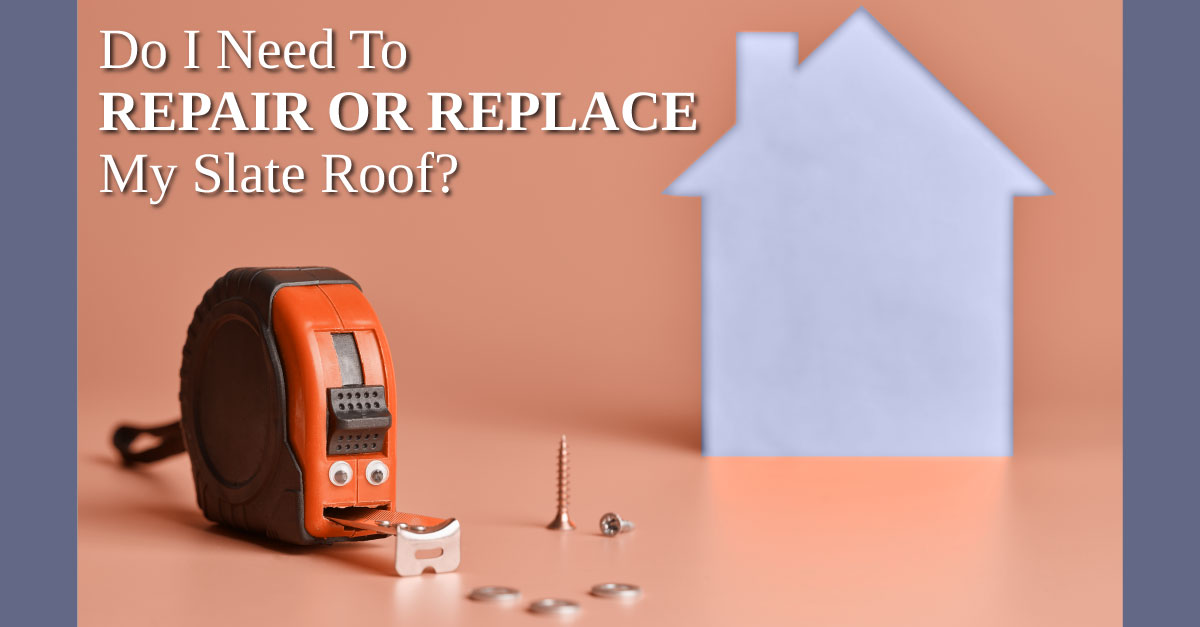Do I Need To Repair Or Replace My Slate Roof?

When it comes to roofing, slate is not only one of the most aesthetically pleasing materials, it’s also one of the longest-lasting! It’s a testament of the power of nature which formed it and the expertise of the craftsmen who hand shape and lay it onto the roof decking!
When properly installed, slate roofs require very little maintenance. They can typically last 100 years to create a timeless look for your home. They can last even longer depending on the roof configuration, type of slate used, and the region of the country where the property is located.
Slate is often associated with state and church buildings these days, but have also been used for agricultural and residential buildings. Longevity and low maintenance are important for all of these structures.
What Can Damage A Slate Roof?
Slate is one of the most durable roofing materials used. Relatively little maintenance and repairs are needed to help it last for decades. When properly maintained it can last well over a hundred and fifty years before needing replacement. Even so, like any material, slate can become damaged and need to be repaired or replaced.
Slate tiles are rigid, heavy and low profile, which makes them much less likely to suffer direct damage than other materials like asphalt or wood shingles. They are subject to direct and indirect wind damage from a particularly blustery day.
Hail is one source of damage to slate roofs that can snowball if left unaddressed. Hail damage appears as holes with sharp edges. It can also appear as broken edges or corners in tiles.
The danger with hail is it often leaves a small hole in the top of the slate and a crater on the underside of the tile. Neither of these can be seen unless the roof is closely inspected. In subsequent rainstorms water will enter the hole and pool under the tile and absorb into the decking, causing often undetected damage which can compound hail damage and require costly repair.
However, the most common form of damage is simple wear and tear from natural aging. Over time thermal expansion and contraction can break down tiles. Depending on the mineral composition of the slate used, tiles can deteriorate and require repair.
Fastening and Flashing
If “a chain is only as good as its weakest link,” for slate roofs, the weakest link is the flashing and fastening, which wear out long before the tiles. The most common materials used for flashing on slate roofs are lead-coated copper, lead sheet, galvanized steel, copper and terne-coated sheet iron.
If the flashing leaks, so will the roof. The solution is to regularly inspect and replace the flashing when needed. Fasteners are another important factor for extending the life of a slate roof.
Repair vs. Replacement
When it comes to repairing or replacement, it’s all about regular maintenance. Slate roofs are designed to last 100 years or more, and when regularly inspected and properly maintained can easily reach this age.
To reach this milestone, broken cracked or missing slates should be replaced promptly by an experienced slater to prevent more serious damage. Whenever slate is removed it’s critical to do these three things before replacing the tiles:
- Inspect the underlying decking for rot
- Inspect the flashing for damage
- Make the appropriate repairs
While regular inspections and prompt maintenance can extend the life of a slate roof, even the most meticulously maintained roof will eventually need replacement. Broken or missing slate tiles are easy to see and repair but it requires careful examination by a roofing inspector with knowledge of slate roofing to determine if the slate is at the end of its service life.
One sign it may be time for replacement is when 20 to 30% of the slates on a roof need repair. In this instance, it can often be more prudent to simply replace the roof.
Two signs which indicate it is time for a replacement roof include:
- Major flaking of the slate
- Powdering on the underside of slates. Since most slate roofs are installed on spaced wood battens, powdering is often visible in the home’s attic.
The best way to keep your slate roof performing for its entire lifetime is through regular inspection and maintenance by an experienced slater. If you live in the greater Norfolk, VA area, give the experts at Steven’s Roofing a call. We are a 3rd generation family-owned roofing contractor with over 70 years of experience in high-end roofing and historic restoration. Rely on Steven’s Roofing for prompt, professional results!


